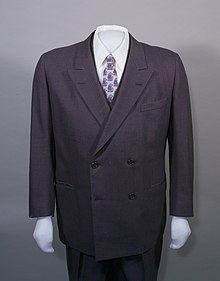Sharkskin
This article may need to be rewritten to comply with Wikipedia's quality standards. (November 2017) |
Sharkskin describes a specific woven or warp-knitted fabric with a distinctive sheen. Sharkskin is a
The arrangement of darker and brighter threads in a twill weave, creates a subtle pattern of lines that run across the fabric diagonally and a two tone, lustrous appearance. Primarily a suiting material, the fabric is sometimes seen in light jackets and non-fashion items such as curtains, tablecloths, and as a liner in
Composition

This section may need to be rewritten to comply with Wikipedia's quality standards. (May 2023) |
Sharkskin has historically been made with different types of natural fibers, including either
Artificial variations
Artificial sharkskin variants used for suiting first appeared in the 1950s. These variants made more significant use
Middle East
British diplomat Sir Terence Clark in the 1950s served in Bahrain. He reminisced that the requisite winter evening wear for a diplomat was a white sharkskin dinner jacket.[5] Lucette Lagnado in her prize-winning memoir about her childhood, The Man in the White Sharkskin Suit: My Family's Exodus from Old Cairo to the New World uses the imagery of the white sharkskin suit to evoke the glamorous evening life in Egypt in the 1950s. Early in Justine, Lawrence Durrell mentions the heroine sitting in front of a multi-panel mirror trying out a sharkskin dress; the book is set in the high society of diplomats and businessmen in Alexandria in the 1930s, a city where Durrell spent much time during World War II, a few years later.[citation needed]
See also
References
- ^ The Textile Institute and Industry - Volume 5. The University of Michigan: Textile Institute. 1967. p. 174.
- ^ Frank Pollatsek, William Seitz, Louis Goldblatt (1952). Fabrics Today and Drycleaning - Volume 1. Origin University of Minnesota: New York Neighborhood Cleaners Association. p. 36.
- ^ Tregonning, Melwyn. Fabric Dictionary. Mel Tregonning.
- ^ Harris, Milton (1962). Natural and Synthetic Fibers Yearbook. p. 156.
- ^ Churchill College Cambridge. "British Diplomatic Oral History Programme (BDOHP)". Archived interview: Former member of the British Diplomatic service Charles Cullimore interviews fellow diplomat Sir Terence Clark on Friday 8, November 2002. Retrieved June 8, 2011.
